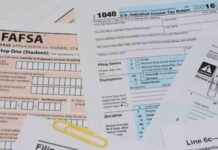Survey Finds Majority of Families Struggle with Updated FAFSA Application
A recent survey conducted by Sallie Mae and Ipsos has brought to light the challenges that students and families are facing when it comes to navigating the Free Application for Federal Student Aid (FAFSA) to secure financial aid for college. The rollout of the most recent FAFSA form was marred by technical glitches and delays, leaving many families feeling overwhelmed and stressed.
The survey, which polled 1,000 undergraduate students and 1,000 parents, revealed that only 29% of families found the updated FAFSA form easier to complete than the older version. This difficulty in completing the form has had a significant impact on students and families, particularly those who are most in need of financial support.
Rick Castellano, vice president of corporate communications at Sallie Mae, highlighted the negative effects of the confusion and delays surrounding the FAFSA application process. He emphasized that those who are most eligible for financial aid are the ones who are disproportionately affected by these challenges.
Despite the hurdles presented by the FAFSA application, the survey also shed light on the unwavering belief in the value of higher education among respondents. An overwhelming 88% of participants agreed that college is still a worthwhile investment in a student’s future, while 86% believed that earning a degree opens up opportunities that would otherwise be out of reach.
However, the high cost of college remains a significant concern for families. While many are willing to stretch themselves financially to afford higher education, the survey indicated that the price of attendance and the availability of scholarships and financial aid play a crucial role in the decision-making process for families.
Castellano emphasized the need for greater clarity and transparency in federal lending programs, as well as increased access to scholarships and grants to ensure that families are maximizing their resources before resorting to borrowing. The botched rollout of the updated FAFSA form only exacerbated the existing challenges faced by families seeking financial aid for college.
The difficulties encountered during the FAFSA application process have had far-reaching consequences. Nearly half of families who completed the 2024-2025 FAFSA forms reported experiencing delays in receiving financial aid offers from higher education institutions. These delays led to feelings of stress among 44% of respondents, prompting some to consider attending lower-cost institutions or exploring alternative financing options beyond the FAFSA.
The impact of the FAFSA delays extended beyond just financial considerations. Some students were forced to reconsider their pursuit of higher education, with 11% contemplating leaving college or taking a break, and 9% actually doing so. The disruptions caused by the FAFSA rollout are expected to persist, with the U.S. Department of Education announcing further delays for the 2025-2026 academic year.
Moving forward, it is crucial for policymakers and higher education institutions to address the challenges faced by families navigating the financial aid process. By improving the accessibility and efficiency of the FAFSA application, as well as expanding scholarship and grant opportunities, students and families can make more informed decisions about their higher education options.
Impact of FAFSA Challenges on Student Enrollment Decisions
The survey findings underscore the significant impact that the FAFSA application process has on students’ enrollment decisions. Despite the challenges and frustrations associated with completing the updated FAFSA form, 36% of students indicated that scholarships and financial aid play a role in their ultimate decision on where to enroll.
The delays and technical glitches experienced during the FAFSA rollout have not only added complexity to the application process but have also influenced students’ perceptions of the financial aid landscape. For many families, the availability of scholarships and grants can make a substantial difference in their ability to afford higher education.
As families grapple with the financial implications of college attendance, it is essential for policymakers and higher education institutions to prioritize transparency and accessibility in the financial aid process. By streamlining the FAFSA application and providing clearer information on available funding options, students can make more informed choices about their educational pathways.
Addressing the Financial Aid Gap
The survey results highlight the persistent financial aid gap that exists for many students and families seeking to fund their college education. Despite the belief in the value of higher education, the cost of attendance remains a significant barrier for many individuals, especially those from low-income backgrounds.
To bridge the financial aid gap, it is crucial for policymakers to explore innovative solutions that expand access to scholarships, grants, and other forms of financial assistance. By ensuring that financial aid resources are distributed equitably and efficiently, students can pursue their educational goals without being burdened by overwhelming debt.
Moreover, higher education institutions must play a proactive role in supporting students through the financial aid process. By offering comprehensive resources and guidance on navigating the FAFSA application, colleges and universities can empower students to make informed decisions about their financial futures.
Looking Ahead: Improving Financial Aid Access and Affordability
As the landscape of higher education continues to evolve, addressing the challenges faced by students and families in securing financial aid is paramount. By enhancing the accessibility and efficiency of the FAFSA application, policymakers can ensure that all students have equal opportunities to pursue their educational aspirations.
Furthermore, expanding scholarship and grant opportunities can help alleviate the financial burden on families and make higher education more affordable for all. By providing students with the resources they need to succeed, we can create a more equitable and inclusive higher education system that benefits individuals from all walks of life.
In conclusion, the survey findings underscore the need for comprehensive reform in the financial aid process to better support students and families in their pursuit of higher education. By addressing the challenges and barriers that exist in accessing financial aid, we can create a more equitable and accessible higher education system that empowers all individuals to achieve their academic goals.




